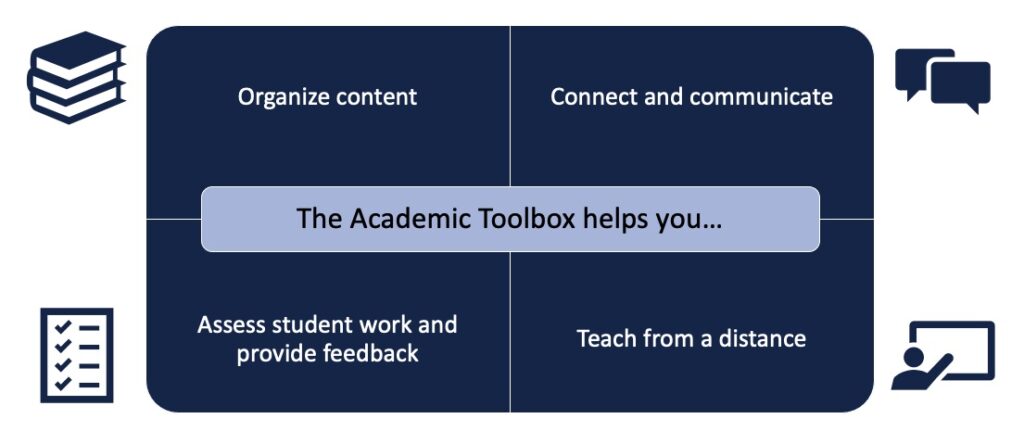Microsoft Teams Meetings
Microsoft Teams Meetings sessions can be used for online/remote course delivery. This allows instructors to quickly enable remote learning for students by creating an audio or video meeting. Advantages of using MS Teams Meetings:
- Integrated with Microsoft 365 – Seamless access for you and students; works with Outlook, OneDrive, and shared files.
- Remote/Hybrid Teaching- Supports video, screen sharing, breakout rooms, and guest speakers.
- Centralized Communication – Meeting links, chat, and resources stay organized in one location.
- Classroom Management Tools – Control presenting, manage chat, and structure small-group work.
- Easy Recording & Sharing- Record sessions automatically and provide accessible playback for students.
Quercus-MS Teams Meetings integration ending– September 15, 2025
What is changing: Starting September 15, 2025, it will no longer be possible to create NEW Microsoft Teams Meetings directly within Quercus courses.
Why is this change happening? Microsoft is ending support for their existing Teams Meetings Quercus integration.
What about my existing meetings? Any Teams Meetings that have already been created in Quercus will continue to work exactly as they do now.
Where are my alternative options? See the Instructions section below for alternate options to schedule virtual meetings in your course.
Will the MS Teams Quercus integration tool work again in the future? Work is in progress to add a replacement Quercus integration for MS Teams Meetings. Please check back here for updates.
Where can I get support? We’re here to help. Contact q.help@utoronto.ca; we can walk through how to create MS Teams meeting in Outlook or even discuss switching to a different virtual meeting tool option.
The Academic Toolbox helps you...
The tools in your Quercus Academic Toolbox can assist with your course delivery by Organizing Content, helping you Connect and communicate with your students, Assessing student work and providing feedback, and allowing you to Teach from a distance.
Typical Course Format?
Most tools in the Academic Toolbox can assist in both online and face-to-face courses. Many tools can provide benefits in either synchronous or asynchronous teaching. Some tools have been primarily designed for one format or another (synchronous/asynchronous), however, may be adapted for any format depending on your pedagogical goals.
To learn more about different teaching modalities, please consult our Online Teaching & Learning page, arrange a consultation with a CTSI Teaching Liason, or contact your Divisional support representative.
Where can I get more support?
Related resources / similar tools
Instructions
-
Create MS Teams Meetings via Outlook on the Web
- Log in to Outlook on the Web using your U of T email address
- Open the Calendar
.
- Select New event
.

In the even creation window:
- Enter a title for the meeting.
- Turn on the Teams meeting toggle (located next to Title).
- Leave the Invite attendees section blank
- Set the date and time of the meeting
- For recurring meetings, select Make recurring, then choose the frequency, adjust the end date, and save.
- Select Save to create the meeting.

-
Share Microsoft Teams Meeting Links in Your Quercus Course
You can share Microsoft Teams Meeting links in your Quercus course using the Rich Content Editor (in Announcements , Assignments , Discussions , Pages, and the Calendar) or by adding them directly to Modules.
Share Teams Meeting Links using the Rich Content Editor
- Open the Teams Meeting in your Outlook Calendar.
- Click the drop-down arrow next to the Join button and select Copy join link.
- In your Quercus course, go to the area where you want to share the link (e.g., Announcements).
- In the Rich Content Editor, select the Link tool in the toolbar and choose External Link.

- In the Text field, enter a name for the meeting.
- Paste the copied Teams Meeting link into the Link field.
- Select Done.
- Save or Publish your content.
Share Teams Meeting Links in Modules
- Open the Teams Meeting in your Outlook Calendar.
- Click the drop-down arrow next to the Join button and select Copy join link.
- In your Quercus course, go to the Module where you want to add the link.
- Select Add Item (+) in the top-right corner of the module.

- From the drop-down menu, select External URL.
- Paste the copied Teams Meeting link in the URL field.
- Enter a name for the meeting in the Page Name field.
- Select Add Item.
Guides
-
- A Quick Comparison of U of T Supported Enterprise Video-Conferencing & Video Meeting Resources

- Getting started with Teams Meetings

- Find a Local Calling number for people joining your Teams Meeting from outside the Greater Toronto Area

- Change who can present in a meeting

- Change participant settings for a Teams meeting

- A Quick Comparison of U of T Supported Enterprise Video-Conferencing & Video Meeting Resources
Last Modified:
4 December, 2025
This work is licensed under a Creative Commons BY-NC-SA 4.0 International License



